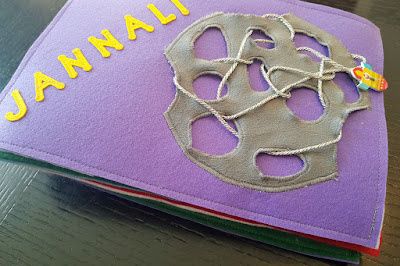Do you sometimes wonder why you went to so much effort making a quiet book page when your little one prefers the simplest page in the book?
I think this page is suited to a child around the age of four, but older children will still have tonnes of fun with it too. They do need to be old enough for you not to worry about them wrapping the cord around their neck and choking on it if you are going to let them play with it unsupervised, however.
How to make my To The Moon and Back quiet book page:
Materials needed:
- velour in gray
- thread to contrast or match for the edges
- background fabric
- 60-100cm cord/ribbon
- rocket button
- hot glue and glue gun
Cut out the template from my To The Moon and Back Quiet Book Page Free Template Pattern.
I used a pen to copy the template onto the back of my velour fabric and sewed zig zag off the edge of the holes after they were cut out, but you could definitely do it before and then cut out the holes too.
I sewed the cord onto the rocket button and then hot glued the loose sections at the back of the button as well, just to make sure it would stay attached and not get in the way when threading. Sew the moon onto your background fabric using zig zag stitch along the outside edge, tucking the other end of the cord under one section. Leave the craters open to allow the rocket to thread it's way in and out through there as well.
I think it made a good front cover.
Join a sew along!
This page is so easy and it comes together very quickly, especially if you use a button for the rocket. We did this page one month in my Facebook Group Quiet Book Sew Along. If you want to join in the fun, join the group, go to the events tab and mark yourself as attending, print the pattern and post your progress photos in event thread. It is a great way to keep yourself motivated, and you can ask all the questions you need and get advice from other quiet book makers.







